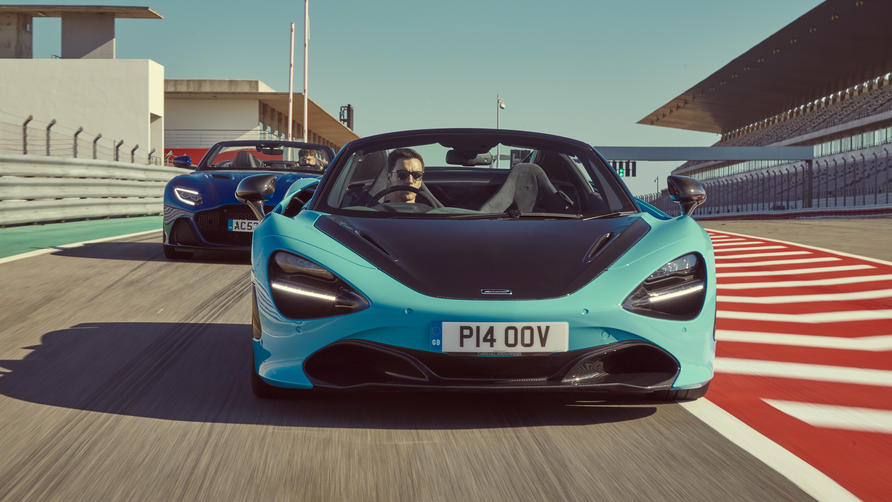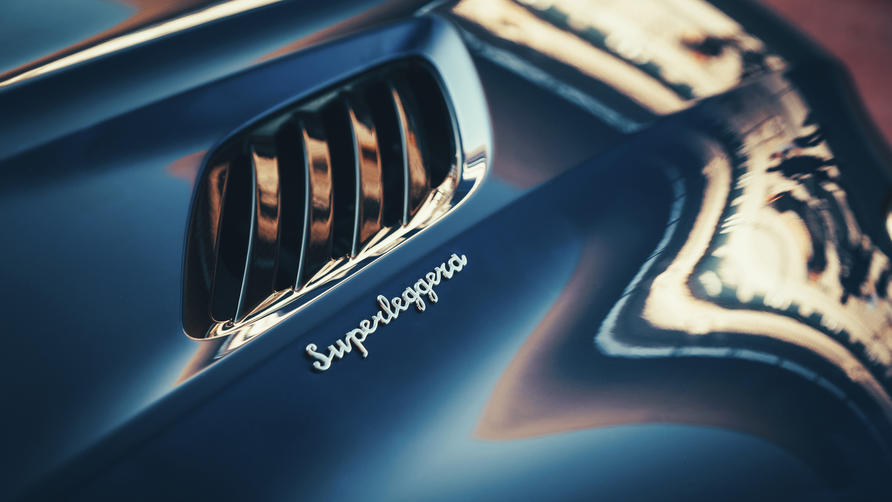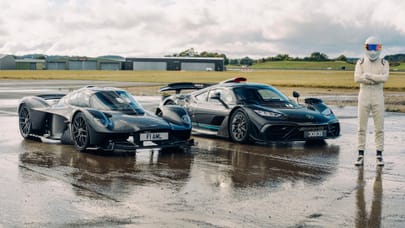
TG24 17.30: McLaren 720S Spider vs Aston Martin DBS Volante
Welcome to the world of wind-in-your-hair motoring... presuming you have hair, that is
My hair is a source of much jealousy at TG towers. Chiefly because I have some, while many of my colleagues do not. I am therefore much better at testing roadsters. Sure, I may not be able to get a McLaren 720S Spider as heroically sideways as Ollie Marriage, but I can certainly tell you how much of a mess you’ll look after a reasonably swift lap of Portimão. The answer, in case you too are follically well-endowed, is a really big one.
Words: Tom Harrison // Photography: Mark Riccioni & Richard Pardon
Nothing here is as fast down the circuit’s more than half-mile long pit straight as the 720S Spider. Not even the Porsche 935 or VW ID.R (which clatters almost immediately into its top-speed limiter). A good exit out of the final corner would see it sail past 175mph, but I chicken out at 160. Mainly because my battered fringe is partially obscuring my vision, but also because Portimão is not to be messed with. Every corner has its own collection of tyre marks immortalising bent metal, shattered carbon and damaged egos. And I enjoy my job very much, thanks.
With enough space, the 720S will do 202mph, roof-down (212mph roof-up)… at which point it would actually be overtaken by the Aston Martin DBS Superleggera Volante, which its maker claims can do 211mph, canvas soft-top folded away or not. That kind of speed doesn’t just mess up your hair, it irreversibly restyles it.
Of course, philosophically, the DBS Volante and 720S Spider are not at all alike, even though they cost roughly the same money – £247,500 for the Aston, £237,000 for the McLaren (both significantly more as tested). By far the two most expensive road cars in our paddock of 15. One is a cutting-edge, mid-engined supercar, and the other a bullish, raffish, front-engined grand tourer. So we can’t really see anyone cross-shopping the two.
It comes as no surprise that the 720S feels more at home here at Portimão. Basically as fast as the Coupe on which it’s based (just 0.1 seconds slower to 124mph) thanks to the same 710bhp, 568lb ft twin-turbo 4.0-litre V8. And because it’s precious little heavier. McLaren didn’t have to make many changes to its super-stiff carbon-fibre tub for the Spider, so weight gain is only 49kg.

The 720S Spider, therefore, feels almost exactly the same as the Coupe. Which is to say, hypercar-botheringly capable yet, with the clever systems left on, affable and approachable. Brilliantly natural steering, superb brakes and exceptional stability mean it feels totally trustworthy and, despite its outrageous turn of speed, not at all intimidating. Around Portimão it is almighty and unbeatable, at least by anything with a number plate. People get into actual fights over the keys, then such is the speed, return minutes later, wide eyed, pale-faced and in need of a bit of a sit-down.
The DBS is, of course, bigger and lardier. Almost a whole Ariel Atom heavier than the McLaren, in fact. Its 170kg weight gain over the Coupe means it’s marginally slower, but we’re still talking serious speed here. The 5.2-litre twin-turbo V12 gives 715bhp and 664lb ft, good for 0–62mph in 3.6 seconds. But it’s after the initial getaway, from 60mph onwards, where the DBS feels its most rapid.
The McLaren’s stupendous launch control and stickier rubber see it accelerate away from a standstill with the thwack of a Tesla; the Aston takes more managing. Its rear tyres are easily overwhelmed by the V12’s prodigious grunt, but once it hooks up, the DBS hurls itself at the horizon very nearly as ferociously as the 720S. And sounds better while doing it. More so from outside the car than in it – people would stop talking to listen to it howl past the pits.

I drove the McLaren first, which in hindsight was a mistake. It’s so natural, bright and energetic, that the much bigger Aston feels almost slow-witted and recalcitrant alongside it. But that’s to be expected – remember, these are very different kinds of cars, with entirely different goals, that will likely be bought by wildly different kinds of people.
Taken in isolation, the Aston isn’t either of those things. It acquits itself well on track, given its size and weight – the Volante uses the same suspension settings as the standard car, so it still goes and stops as well any big GT I’ve ever driven. There’s no shudder from the chassis as you bounce it over kerbs, and the steering is especially good – well-weighted and measured, with none of the hyperactivity of, say, a Ferrari 812. But the racetrack is not the DBS’s natural habitat, and it shows. One of my colleagues asked me afterwards why I was going so slowly. I didn’t have the heart to tell him that was simply as fast as I could make it go.
Top Gear
Newsletter
Thank you for subscribing to our newsletter. Look out for your regular round-up of news, reviews and offers in your inbox.
Get all the latest news, reviews and exclusives, direct to your inbox.
So, to give Chris Harris a bit more playtime with the racers, I quietly commandeer a couple of colleagues, make my excuses (“Gents, we’ve run out of Haribo”) and head for the hills. Literally.
Pausing briefly to nail the cars through Portimão’s access tunnel to confirm that, yes, the Aston sounds tremendous and the McLaren... doesn’t, we convoy out of the circuit in search of actual roads.
What’s immediately obvious is that these are both excellent road cars. The 720S is especially impressive – like McLaren paid as much attention to day-to-day usability as it did making the thing crazy fast. Visibility is superb, the engine and gearbox behave themselves in traffic and the ride is just uncannily good – typically McLaren.
[node:field_inline_galleries-themed-delta:0]
It’s as usable and practical a mid-engined supercar as you’ll find anywhere – one you could conceivably drive every day. If the vast amounts of attention it gets from other motorists don’t worry you, that is. We parked it beside our hotel’s pool for a quick photo, then couldn’t move it for an hour because people were queuing up to have their picture taken with it. I could’ve made a fortune.
But were we buying one of these cars to use everyday, it wouldn’t be the McLaren. The DBS might be physically bigger and harder to see out of, but it’s without a doubt the car you’d want to spend more time in. Driving the Aston is a feelgood experience the McLaren can only aspire to – a proper event. It goes, rides and steers with such confidence that within minutes it would have even the most vociferous of doubters completely charmed.
The McLaren is astonishing. Undoubtedly the better track car and deserving of high-praise. The Coupe won Speed Week outright in 2017, remember. But there is a whiff of built-in obsolescence about the whole thing. As though there’ll be another one next year, and another one after that, and another one after that. It’s the iPhone of supercars – buy one, by all means, just do so knowing a better version will be along soon, and that it will make yours instantly less desirable, less valuable.
There’s none of that with the Aston, which may well be the last of its type. And thanks to a stowable wind-break, it’s also much kinder to your hair.
ASTON MARTIN DBS SUPERLEGGERA VOLANTE
Price: £247,500
Engine: 5.2T, V12, 715bhp, 664lb ft, RWD
Performance: 0–62mph in 3.6secs, 211mph
Weight: 1945kg
Power to weight: 368bhp/tonne
McLAREN 720S SPIDER
Price: £237,000
Engine: 4.0T, V8, 710bhp, 568lb ft, RWD
Performance: 0–62mph in 2.9secs, 212mph
Weight: 1468kg
Power to weight: 484bhp/tonne
Trending this week
- Car Review
BMW iX3








